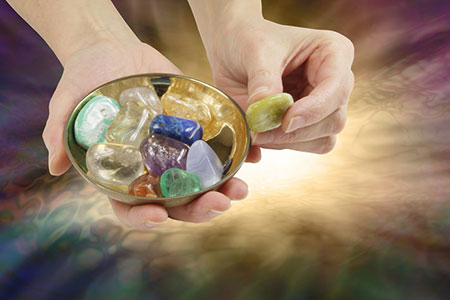Make Your Own Magical Moon Water
 The Moon, our closest celestial body, is strongly associated with the element of water. One way we can harness its powerful energy is by making moon water. Moon water is a powerful tool for energy cleansing and balance, and for strengthening spiritual connection.
The Moon, our closest celestial body, is strongly associated with the element of water. One way we can harness its powerful energy is by making moon water. Moon water is a powerful tool for energy cleansing and balance, and for strengthening spiritual connection.
The energy charging of moon water can be done at any time, but it is most ideal with the Full Moon. All you need is distilled or fresh water, a container, and a strong sense of intent.
Choosing the right container for your moon water is key. Think about what you plan to do with it: bathing, drinking, watering plants. If you are going to leave the container outside and overnight, consider a mesh or other permeable covering or lid so nothing except moonlight can get inside.
You can also include lunar affinity crystals, such as moonstone, clear quartz, or opal in the making of moon water. You can leave it in the container where it will receive an optimal amount of moonlight, then retrieve it in the morning.
Also, consider the astrological placement of the moon when making your moon water. For example, if you are setting an intention for extra insight and focus in your business or career, then a Full Moon in hardworking Capricorn is an ideal time to make some moon drinking water for the office.
As with any spiritual practice or manifesting ritual, stating your intentions clearly and firmly beforehand is vital. Remember to also extend gratitude to the Moon for her power and positive energies.
Let Your Authentic Self Shine
 Most people at some point change something about ourselves in the hope of being better liked or accepted by others. Whether it’s a group of friends, a potential romantic partner, or the manager at work, there is constant pressure to conform and fit in. But in the long run, does this help? The truth is: it really doesn’t.
Most people at some point change something about ourselves in the hope of being better liked or accepted by others. Whether it’s a group of friends, a potential romantic partner, or the manager at work, there is constant pressure to conform and fit in. But in the long run, does this help? The truth is: it really doesn’t.
The notion of simply being your authentic self is challenging in an era where everyone seems to be seeking approval and attention. Therefore, the authentic self or the true version of our soul is something one hardly sees in the digital era of social media, influencers, likes, and followers.
However, we may think that a person we see online is someone others won’t like. Maybe our internal critic sees that person as ‘too much’ of something or ‘not enough’ of another. But we are often mistaken, as someone being true to themselves and keeping it real is what most people are spontaneously drawn to.
You might feel like you’re the only strange person at work, or the black sheep of your family, but you’re not the only one. There are thousands of ‘odd’ people out there right now with the same doubts as you!
The old saying ‘there’s a lid for every pot’ is always good to keep in mind. Your authentic self is just what someone else has been looking for. If you feel you don’t fit in with the crowd, take a step back and ask yourself whether you truly want to be part of it anyway? Knowing your true value and finding the things most important to you, will help determine who you want to surround yourself with.
It’s also important to set healthy boundaries. If you feel peer pressured into joining a group, or liking something simply to fit in, ask yourself if this is true to your core. Does it resonate with your authentic self?
It Will Happen When The Time Is Right
 Most psychics find it almost impossible to read for themselves, or for friends and relatives. It is difficult to remain objective in readings for people who are very close to us. It is therefore common practice for psychics to read for each other when the need arises.
Most psychics find it almost impossible to read for themselves, or for friends and relatives. It is difficult to remain objective in readings for people who are very close to us. It is therefore common practice for psychics to read for each other when the need arises.
Many years ago my psychic mentor and I were trading readings. During my reading she told me I would one day have to choose between two men. Of course, I am like everyone else and so I wanted to know when it would happen?
As a professional psychic reader I knew from personal experience that the prediction of the timing for events is really hard to do. But I still wanted it to happen right then and there! I was less experienced then and obviously had a lot to learn. I don’t have patience at all, but sometimes in life you are made to learn important life lessons.
It took over a decade, but my mentor’s prediction finally happened. Yes, ten years later these two men were finally both in my life, just as she had forecasted they would!
Doing psychic readings professionally I am often asked during a reading, “When exactly is so-and-so going to contact me.” Then, if that contact doesn’t come quick enough, there comes the stress and fears. This can cause a bigger misunderstanding, thinking that commutation won’t ever happen. To make matters worse, timing is especially difficult to predict when a person doesn’t have patience or doesn’t give things time to happen.
If you really think about it, would it really be so much easier or better to have everything that we want happen right away? If so, will we be truly ready for it, and will we also appreciate the good things we already do have in our lives?
The World Needs Highly Sensitive People
 You’re being way too sensitive. Get over yourself. Don’t take everything so personally. Why are you being such a cry baby?
You’re being way too sensitive. Get over yourself. Don’t take everything so personally. Why are you being such a cry baby?
If you are a highly sensitive person (HSP) you have probably had others say such things to you at some point. But there is nothing wrong with you. According to renowned HSP researcher Dr. Elaine Aron, your sensitivity trait is perfectly normal. In fact, it is found in 15 to 20 percent of the population, which is way too many people for it to be a ‘disorder.’ However, it is still rare or exceptional enough to be misunderstood by most people around you, if they are part of the remaining 80 percent ‘non-sensitive’ population.
The highly sensitive person has increased sensitivity to physical, emotional, or social stimuli. It is also referred to by some experts as having sensory processing sensitivity. HSPs are more reactive, for example, to negativity, unpleasant emotion, or violence.
Because much of western culture is dominated by extroverted types, the more reflective, introspective HSP sometimes feel lost in the shuffle. They are the ones who need extra time to process things, who may sit by ourselves, or in like-minded pairs, at a large gathering.
HSPs seek to form deeper bonds and keep the peace instead of fighting. A noisy, chaotic, and rude world is often very overwhelming for them. It can be especially difficult for HSP men in a misogynist society, since many of the HSP traits are not celebrated as traditionally ‘masculine.’
The truth is that the world needs HSPs and their unique gifts. The HSP’s abilities to console, nurture, heal, and build relationships are invaluable for humanity. We all want a world where universal qualities like justice, empathy, and honesty are celebrated and practiced.
At work, they are the types who notice everything and attend to the smallest details, though they may often be overlooked for promotion. In family life, they are the ones who settle disagreements and find common ground. In the political world, they are diplomats and peace-keepers.
Crystal Energy Work And Prosperity
 Crystals used in spiritual practice can help us manifest many good things in our life. If you’re specifically looking to increase your financial security, wealth and prosperity, or maybe find that perfect job or start that successful business (or even win that lottery ticket), try adding some new prosperity crystals into your daily spiritual practice.
Crystals used in spiritual practice can help us manifest many good things in our life. If you’re specifically looking to increase your financial security, wealth and prosperity, or maybe find that perfect job or start that successful business (or even win that lottery ticket), try adding some new prosperity crystals into your daily spiritual practice.
There are many ways you can bring these crystals into your life for financial success. Keeping a few of your favorites in a purse or wallet, or on your desk at work, is the best way to have them close at hand. Traditionally, the southwest corner of a space is associated with prosperity and wealth, so try a bowl filled with your favorite crystals and place it there. Some practitioners prefer to place a collection of these crystals in a prosperity grid. Maybe a piece of jewelry made with some of these crystals?
It’s also important to consider all kinds of wealth and prosperity (good luck, business sense, spirituality, knowledge) and not just material goods when using your crystals. Each of the crystals and stones below has unique abundance properties, so choose the ones most unique and meaningful to your situation.
The main thing to remember in your crystal energy work is your intention. Prosperity is something all of us aspire to, and it’s certainly great to have lots of extra spending money, but we also must remember different kinds of ‘wealth’ exist, especially the wealth of the heart. We must also seek to bless others, so always remember those in need and less fortunate. Wealth and prosperity without love and sharing is meaningless.


